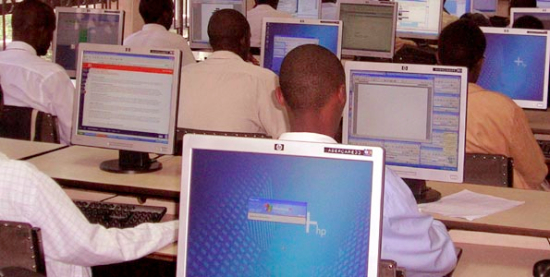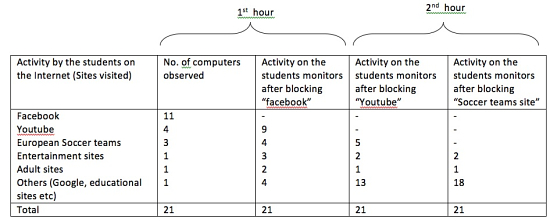Experiment on Classroom Internet Usage by Secondary School Students

I am Martin Mungai, a secondary school teacher in Kenya, but currently on study leave undertaking my studies at Hokkaido University of Education in Japan. I am keen on researching children and information media. I wish to share my experiment that i carried a year ago on the use of Internet in classrooms in Kenya. I am aware that not much educational research in Kenya has been done in this area.
In my school we had new software installed in the computer lab. The software allowed the teacher to control the students PCs from one location, which we would call the “teacher control centre” (TCC). The TCC allowed the teacher to view all the students’ workstations and even take over the control of the students PC without the teacher having to physically move to the particular student. The students were not informed of the features of the newly installed software.
I sampled a group of students from form 3, they fell in the age bracket of (15-16) years. They were allowed an uninterrupted 1-hour session to browse the Internet; all the while I kept an eye on the TCC, monitoring what each group was doing.
Observation
I did not give them any prior information on what websites to visit, within 5 minutes, of the twenty 21 computers that we had in the room (see figure 1), 11 had already logged in to a social website; facebook, 4 were on youtube, 3 were on popular European soccer clubs 1 was on an entertainment site 1 was on adult site and 1 was still googling. The computers were shared between 2 students and about 4 were shared by 3 students.
After 1 hour, I blocked the popular social networking sites and none of the computers could access it. I noted that a group of students affected were getting irritated and they tried logging into other sites, next I blocked youtube, the irritation now became more evident as the noise levels in the lab was raised. I next moved to block the sites of popular European teams, and the reaction was almost instantaneous, some students clicked and others started peeping at others screens, one student was even courageous to come forward and tell me that the Internet was not working. I feigned ignorance and told him to try other sites, I even suggested in passing, “try educational sites”.
The students who had initially taken over the control of the computer in their workstation gave up the mice and the keyboard and they became passive participants. For the next 1 hour I observed that students were keen to search on educational materials in science, history, computing, career opportunities and institutions of higher learning. See the table below

It was very evident that social networking services (SNS) such as facebook is very popular with students. It was not possible to establish the number of students who had registered on facebook. Of particular concern were the students who visited the adult sites. In spite of several posters displayed on the wall, and verbal instruction given to the students, some still went ahead and browsed the adult sites. I sought to know where they had got information about those sites, and the response was almost instantaneous; “From friends”. Interestingly almost all the students knew the code name of the adult sites “gwati”. This is a clearer indicator that peer influence plays a big role in motivating the students on visiting the adult sites.
Conclusion
The above case study should however not be used to make a generalized conclusion that the same effect would be observed in a different set –up say for example a girl school, or a rural school. A more comprehensive study would probably yield different results although it’s only a slight deviation that would be expected.
This clearly demonstrated that, students when left on their own to use the Internet will only engage in areas that seem to entertain and socialize. Proper supervision, control and guidance will help the students unlock their potential in looking for information that will have direct impact on their academic life. Further when 2 or more students share a computer, they are more creative in terms of the information that they look search for in the net.
As pointed out, Internet appears to have some educational effects on children’s attitude towards learning. For example, Clifford Stoll (2000) argues that multimedia systems such as computers or Internet may lower or decrease children’s problem-solving ability, intellectual curiosity and motivation for learning.
However, this can be overturned by offering guided supervision to the students on the use of the Internet. Further, implementation of “Information Moral education” is as important as using an interactive hands-on approach to moral learning. Teachers and educators should emphasize the need to balance both the positive and negative aspects of ICT.

Hello Martin, this was very interesting and it made me think about a certain method that we have been using in our organisation for our eLearning courses. Based on Actions Learning & PBL, we have embraced Social media as a tool that can be used for Learning. For instance, we recognised that a large number of young people would rather visit facebook atleast 10 times/day, than our Learning Management System. As a result, we have integrated Youtube, Facebook, Ning and other social media's into our LMS. Instead of the common way of packaging learning content in Text format, some of our content is on Youtube videos, student discussions and interactive sessions have been organised on Facebook pages. We also encourage the students to use Social media to document the results of their assignments. Perhaps this is one approach that can be integrated into Kenyan ICT supported Learning methods? Giving the teacher control of the classroom computers is a hardware issue, but it cannot facilitate learning.
I totally agree with you Eva, a large percentage of our secondary school students in Kenya are using the Social Networking sites more than they do on any educational sites. Recent survey by the communication comission of Kenya (CCK) did state that there are Total of 1,241,720 Facebook Users in Kenya, out of which 63% are male users and 37% are female users. Using Social media in learning would perhaps in a way motivate the students, Reiko Ando et.al (2005) suggest that, Internet use by students outside classes improved the students ability to collect information and the ability to communicate information. I would certainly love to hear more on how you have integrated social media into your LMS.
we use wikispace and blogs inside and outside LMS.
Martin, this was a timely post for me as I am currently consulting with a ICT learning center in Tanzania & a large percent of the students spend their practice time on Facebook. Though we introduce internet research techniques & blogging etc, it appears that students invariably spend 85-90% of their time on social networking sites.
I like Eva's approach to embrace the reality and be innovative in our approach towards social media. I too will look to integrate it more fully with our LMS (Moodle)
Our PC's are installed with Edubuntu & additional filtering of inappropriate key words to help limit access to 'adult content' sites, through the use of DansGuardian
On a final note, giving teachers control of the computers is not only a hardware issue, but can be a invaluable teaching tool when resources are limited. iTALC provides the functionality to allow teachers or a student to share their screen with the lab in the absence of a projector.
I look forward to reading more about your progress and also to share our experiences in the near future.
Martin – Thank you for this interesting post! You highlight some key issues that teachers face when incorporating Internet technologies into the classroom. As you mentioned, it would be interesting to conduct comparative studies on different demographics to see if there are changes in the trends.
Eva – I'd be interested to learn more about how your LMS incorporates social media into its platform, as this seems an excellent way to use these popular site to engage students in learning, instead of making them 'forbidden'. Great idea!
Martin- this is an interesting study. Ultimately the idea of blocking site does not augur well with me. Y tube for instance us a lot of useful videos. The social media Facebook, twitter are powerful social medias that can we can leverage on. Useful critical thinking and creativity can be enhanced with the social media. If you check on the revised digital Blooms by Andrew Churches you will see the role of the social media- here find the link http://www.techlearning.com/article/44988.
With the use of an LMS i have experience with Moodle, you can embed the video on the resource area or even on the Power points uploaded. Links tend to distract the students learning.
We must inculcate discipline to our students, yes responsible internet use. What happens tomorrow when they are employed in an organization with stringent use of internet. I know of a number of my fomer students working in reputable organisation who have fired for using Internet in a manner not consistent with the companies policy. This applies with a subject like biology, and the adminstrator has blocked the word SEX. Students miss a lot